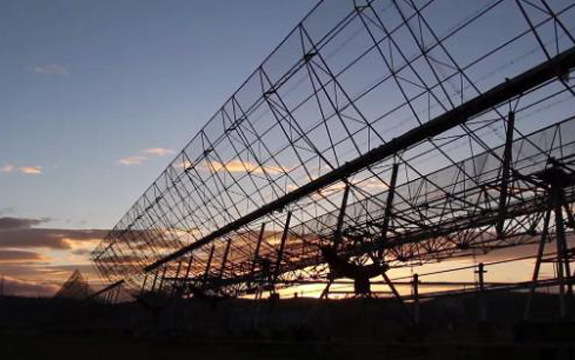Star professor awarded fellowship

In Summary
New life for an old telescope: The Molonglo radio telescope will be used in Professor Bailes’ five year quest for exploding stars during his Laureate Fellowship. Credit: Pablo Rosado, Swinburne University of Technology.
Swinburne University of Technology’s Pro Vice-Chancellor (Research) Professor Matthew Bailes has been awarded a prestigious Australian Laureate Fellowship, worth more than $2.8 million, by the federal government.
Laureate Fellowships recognise outstanding leaders and fund them to pursue exciting research projects that develop research capacity and have the potential to make high-impact scientific breakthroughs.
Professor Bailes’ fellowship will enable his team to transform the largest telescope in the southern hemisphere into a machine that will attempt to count the number of atoms in the Universe.
This machine will monitor millions of cubic light-years for exploding stars by observing their death-rays when they impact the telescope. Encoded in their radiation is a ‘counter’ that can determine how many electrons – and therefore how many atoms – they have passed.
Bailes’ team has developed code for a massive array of computer graphics cards that enables them to perform 250 trillion calculations each second to search for rare bursts of radio emission whenever the telescope scans the sky. This was previously not possible.
In partnership with the University of Sydney, ANU and CSIRO, Swinburne has deployed a supercomputer at the mile-long Square Kilometre Array pathfinder Molonglo Radio telescope, located near Canberra, which is constantly searching for the faint bursts of emission thought to arise from stars half way across the visible Universe.
The program will also include the opportunity for school children to use the giant telescope to watch a neutron star orbit a white dwarf at dizzying speeds, and see evidence of Einstein’s theory of relativity in action to inspire an interest in science and technology.
Professor Bailes’ team is a world leader in advanced radio astronomy instrumentation.
Team member Dr Willem van Straten is leading the design of the Square Kilometre Array’s pulsar processor, and the Centre for Astrophysics and Supercomputing has been involved in many exciting discoveries of exotic stars, ranging from the celebrated ‘diamond planet’ to exhaustive tests of Einstein’s theory of relativity.
The awards were announced by the Minister for Education and Training, Christopher Pyne and are funded through the Australian Research Council.
“The research programs of the 15 Laureate Fellows announced today will deliver outcomes that will benefit our nation, its economy and our people,” Mr Pyne said.
The 15 researchers and their teams will receive a total of $42 million over the next five years.

